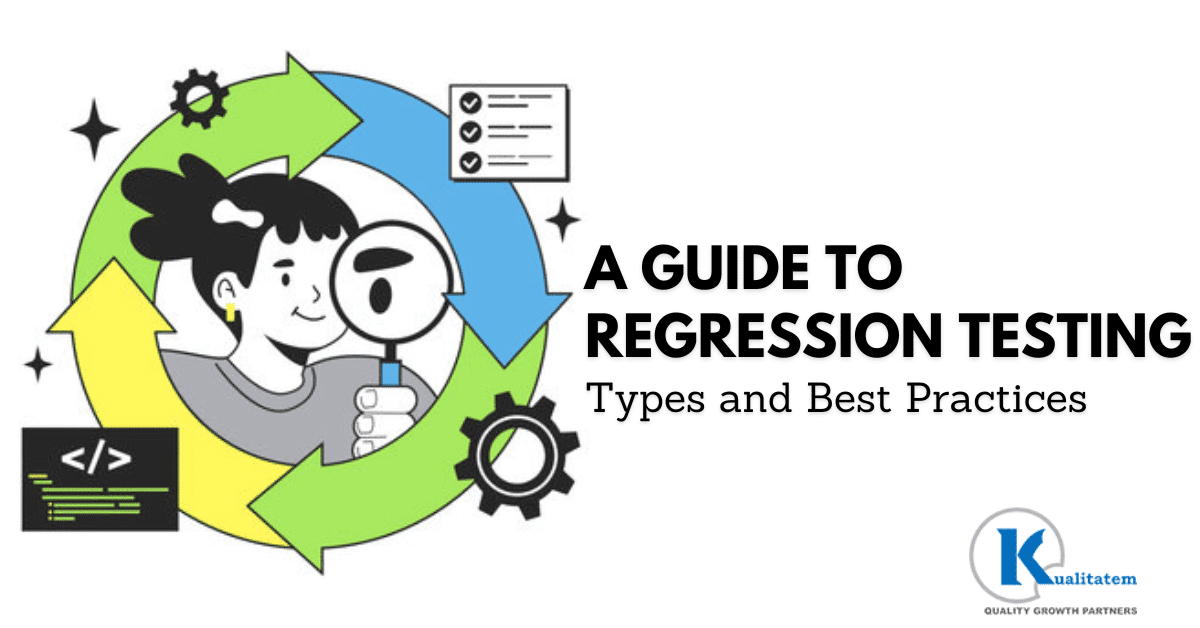A Guide to Regression Testing: Types and Best Practices

- March 15, 2023
- admin
As software systems become increasingly complex when new features are added, it becomes more challenging to perform comprehensive regression testing. To overcome these challenges, developers and testers must follow established best practices and use various types of techniques.
In this guide, we will explore the different types and discuss the best practices for effective and efficient testing.
What is Regression Testing?
It is a process that ensures that changes or updates made to an application do not negatively impact its existing features or functionality. This process involves re-executing previously developed cases and checking if they still pass or if any new defects have been introduced.
The goal of regression is to detect and fix any unintended consequences of software changes, such as new bugs, errors, or performance issues.
Depending on the size and complexity of the program, it can be done manually or automatically. Automated way is more efficient and effective approach, as it allows them to execute cases quickly and repeatedly. Overall, it is a critical process in program development that helps ensure the quality and reliability of the application.
When Should This be Performed?
It should be performed in the following scenarios.
After Bug Fixes
Whenever a bug is fixed, it is essential to perform it to ensure that the fix did not cause any new defects or issues in the app. It helps ensure that it works as expected and that the bug fix did not break any other parts.
After New Features are Added
As new features are added to the program, it should be undertaken to ensure that they do not disrupt the existing functionality of the app.
After Changes to the Environment
Changes to the operating system, hardware, or software environment can have unintended consequences on the application’s functionality. It should be carried out to make sure that the program still functions properly in the new setting.
After Updates or Upgrades
Whenever the app is updated or upgraded, regression testing should be performed to ensure that the update did not cause any new issues. This is especially important when the update involves changes to the core components, such as
- Database Schema
- Libraries
- Frameworks
Different Types of Regression Testing
There are several types that teams can use, depending on the nature of the changes to the application. Some of the most popular varieties include the following.
Unit
This entails checking distinct pieces of code, such as methods, classes, or functions, again after modifications have been made. It is typically performed using automated cases and is useful for catching bugs introduced by changes to specific code units.
Partial
This involves checking a subset of the entire suite after changes have been made. It is useful when there are time or resource constraints and when the changes made are small or localized.
Full
This type entails rerunning the complete suite following modifications. It is the most comprehensive approach and is useful when the changes made are significant or widespread.
Selective
This involves selecting a subset of cases from the entire suite based on their importance or criticality. It is useful when time and resources are limited, and the focus is on the most critical parts.
End-to-End
This involves evaluating it completely—all of its features and functionalities after modifications have been made. It is useful for detecting issues that may arise from the integration of different parts of the app.
Retest-All
This involves checking all cases, even those that have passed previously. It is useful when the software team wants to ensure that no new issues have been introduced into the application.
What are the Best Practices?
Here are some best practices:
Create a Comprehensive Test Suite
This should cover all aspects of the functionality.
- Test Cases for all Features and Functions
- Negative Scenarios
Automate Testing
To speed up the process, it’s essential to automate as much of the processes as possible. This includes
- Automating Case Execution
- Data Preparation
- Reporting
These tools can help reduce the time and effort required and improve the accuracy and consistency of the results.
Prioritize Test Cases
Not all cases are created equal, and some may be more critical than others. It’s essential to prioritize them based on their importance and the likelihood of failure. This allows teams to focus on checking the most critical parts first and ensures that the most important bugs are caught early.
Use Version Control
Version control tools, such as Git, can help keep track of changes to the code and cases. This ensures that the right versions are used for checking and helps identify the cause of any issues that arise.
Conduct Regular Tests
Regression should be performed regularly, preferably after every significant change. It helps catch issues early and prevents them from accumulating and becoming more challenging to fix later on.
Collaborate and Communicate
Testing is a team effort, and it’s essential to collaborate and communicate effectively to ensure that everyone is on the same page. This includes
- Sharing Test Results
- Identifying Issues
- Coordinating Efforts to Fix Them
Conclusion
In conclusion, software regression testing is a critical part of the SDLC that helps ensure that changes to an application do not introduce new bugs or issues. There are several types of it that teams can use, including unit, partial, full, selective, end-to-end, and retest-all. Each type has its benefits and should be chosen based on the nature of the changes made and the available resources.
To achieve effective software regression testing, it’s essential to follow best practices such as creating a comprehensive suite, automating as much as possible, prioritizing test cases, using version control, conducting regular checks, and collaborating and communicating effectively. By following these best practices, teams can catch issues early, reduce the risk of bugs and failures, and deliver high-quality software that meets users’ needs and expectations.











